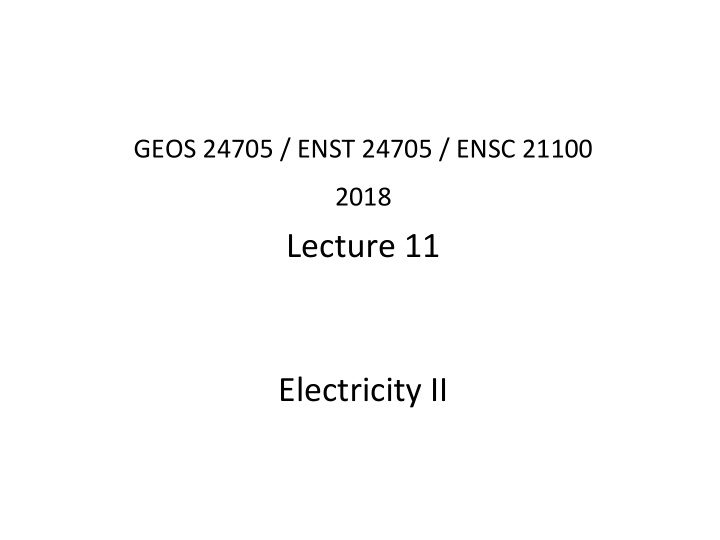



GEOS 24705 / ENST 24705 / ENSC 21100 2018 Lecture 11 Electricity II
Motor and generator are converse of each other 1) Generator Turning something (in the presence of a magne1c field) can make electricity (i.e., convert work to electrical energy). 2) Motor Electrical energy (given the presence of a magne1c field) can turn something (i.e. convert electric energy to work) Westinghouse commercial AC generating station, 1888 Electricity has a chicken-and-egg problem – why develop a motor without a generator to drive it? Why develop a generator without a market for its power?
BaWeries allow electricity research to start with motors RotaLng electromagnet, Wm. Ritchie, 1833 RotaLng electromagnet, Wm. Sturgeon, 1838 RotaLng wire in Hg, Faraday, 1830s ReciprocaLng engine, Daniel Davis (?) 1840s DC electric fan, Edison 1898 Revolving armature engine, Daniel Davis 1848 Images from: Sparkmuseum
Generators followed quickly S1ll only as physics demonstra1ons, no prac1cal use Faraday’s generator, 1831 Pixii’s dynamo, 1832 A metal disk spinning between A magnet spinning under coils of wire poles of a magnet Commutated DC current Source: Wikimedia, original unknown Source: Niethammer, F.; Ein- und Mehrphasen-Wechselstrom- Erzeuger ; Verlag S. Hirzel; Leipzig 1906, via Wikimedia
LighLng is a longstanding societal need Wall-hung oil lamp, 1800s 1861 locomo1ve – pre-electricity First gas streetlights 1798 gas or oil-powered
... so long interest in using electricity for lighLng Carbon arc light powered by baQeries 1800: Alessandro Volta demonstrates glowing wire from Joule heaLng 1802: Humphrey Davy produces light by passing current through plaLnum strips 1802 (ca.) : Davy also invents the electric arc light, powered by liquid baWeries ... need to wait for genera1on before it’s prac1cal to power electric lights 1879: First public electric lighLng: arc lights installed in Public Square, Cleveland ... meanwhile, development on incandescent bulbs con1nues ... 1844: John Starr files for U.S. patent of bulb w/ carbon strip, vacuum, mercury seal 1860: Joseph Swan gets BriLsh patent for bulb with carbonised filament, parLal vacuum 1874: Thomas Woodward gets Canadian patent for lightbulb with carbon filament 1876: Woodward gets U.S. patent, grants exclusive license to Thomas Edison
LighLng becomes the “killer app” for electricity Sawyer electric lamp, 1878 patent 1878: William Sawyer founds Electro-Dynamic Light Company, patents a lightbulb 1878 + 3 months : Edison forms Edison Electric Light Company (J.P. Morgan invests) 1879: Edison patents carbon-thread lightbulb. Nearly a decade of li1ga1on follows... claim: higher vacuum, more effec1ve filament, higher resistance 1880: > 6000 electric arc lights are in factories, Thomson-Houston Electric Co. forms in U.S. 1892: Thomson-Houston merges with Edison to become General Electric 1890s: “War of the currents” sets the electrical standard for the United States and world 1904: First tungsten filament (Kuzel, Vienna) à William Coolidge at GE tries to imitate 1914: 88.5 M incandescent bulbs are sold, 85% non-carbon
LighLng paves the way for using electricity for work
ConverLng electrical energy ßà work requires a magneLc field Ampere’s law: current flowing in a wire generates a magneLc field If I flow current through a wire loop in a magne1c field it will rotate à motors Faraday’s law: changing magneLc flux in a wire loop induces current to flow If I rotate a wire loop in a magne1c field it will produce a current à generators
Force on a brushed DC motor Magnetic field lines video
Force on a brushed DC motor Magnetic field lines video
Recommend
More recommend